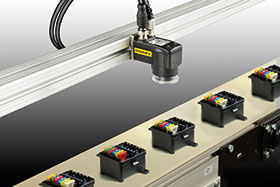

Industrial production of goods is subject to strong competition today. Successful manufacturing companies have a high degree of mechanisation, increasing quality standards, increasing manufacturing speeds, and lower manufacturing costs. Consequently, the production processes have to be optimised and manufactured parts must be checked, preferably 100%, and while production speeds rise.
Human inspection
A human inspector cannot maintain a high level of defect detection for long periods of time. Within 15 minutes of the start of an inspection shift, the defect detection capability of the inspector can be reduced drastically. The number of missed defects will be influenced directly by the complexity of the item being inspected, the time of day and the particular day of the week.
Machine vision
Machine vision involves the use of digital cameras and image processing in industrial applications to ‘see’, typically for tasks such as:
• Quality control – 100% sub-assembly and component presence checks, dimension checks, etc.
• Part type identification.
• Part location, e.g. for robotic applications.
• Part orientation and measurement.
• Assembly integrity checks.
The producer requires a solution that works, which implies:
• Detection of defective parts within a defined tolerance.
• Repeatability.
• Reliability over a number of years.
• Minimal rejection of ‘good’ parts.
A properly designed and implemented machine vision/visual inspection system is capable of performing these tasks 24 hours a day, 365 days a year, more reliably, more accurately, at a lower cost and at a higher speed than human inspection.
However, a machine vision task may appear easier than it is, for the simple reason that every human has an innate ability to perform image processing and analysis. Our eyes focus and automatically adjust to changes in light intensity, the image processing cluster in our brains consists of a number of parts or sub-systems, the primary visual cortex which performs some pre-processing functions, and other sub-systems which handle shape, colour, movement, spatial position measurement, etc. Our brains will even fill in missing parts of an image if necessary.
It is not as effortless for a digital camera and microprocessor. This is an unusual situation for us humans as we are used to dealing with sensors or measuring devices which can far out-perform our own on-board ones, e.g. consider measurement of temperature, pressure, humidity and flow rate, for example.
Factors such as varying light intensity, light source position, object colour, reflectivity and viewing angle are not so easily compensated for by a machine vision system, which can be easily confused by variations that are barely noticeable to humans. This can have a big impact on machine vision system performance. Achieving accuracy, reliability and repeatability is one of the primary goals of machine vision hardware and software architects.
The requirement
Design of a reliable machine vision system requires a thorough understanding of the operation and specifications of digital imaging, optics, lighting and image analysis software. Ignorance in any of these fields can result in an inaccurate and unreliable inspection system.
Westplex has over 15 years’ in-depth experience in designing and building machine vision systems that work, and are distributors for the industry-leading manufacturers of all categories of machine vision components. Westplex offers system design, training, advice and technical support to system integrators and end-users.

© Technews Publishing (Pty) Ltd | All Rights Reserved